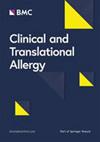Association between telomere length and atopic dermatitis among school-age children
Abstract
Background
Atopic dermatitis is a common chronic skin disease in children. Whether telomere length is associated with atopic dermatitis remains unclear. This population-based case-control study aimed to investigate the association between telomere length and atopic dermatitis in school-age children.
Methods
In this cross-sectional analysis, we included 1084 singleton term-born children (608 males; mean age 6.4 years) from the Longitudinal Investigation of Global Health in Taiwanese Schoolchildren cohort. Telomere length was measured using quantitative real-time polymerase chain reaction, log-transformed and was analyzed in quartiles. The main outcome was atopic dermatitis defined as having physician-diagnosed atopic dermatitis and the presence of atopic dermatitis in the last 12 months. Regression analyses were used to assess the relationship between telomere length and atopic dermatitis.
Results
Telomere length was significantly inversely associated with childhood atopic dermatitis after adjusting for child's age, sex, overweight or obesity, birth season, childhood allergic diseases, environmental tobacco smoke, parental history of allergic diseases, parental educational level, and breastfeeding status (p_trend = 0.01). Specifically, when telomere length was classified into quartiles, children in the shortest (fourth) telomere length quartile had a 1.88-fold higher probability of atopic dermatitis compared to those in the longest (first) quartile (95% confidence interval: 1.13–3.14). Stratified analyses showed that the associations were stronger in males and non-breastfed children, with no significant associations observed in females or breastfed children.
Conclusion
This study provides new evidence suggesting an association between shorter telomere length and atopic dermatitis in school-age children.


 求助内容:
求助内容: 应助结果提醒方式:
应助结果提醒方式:


